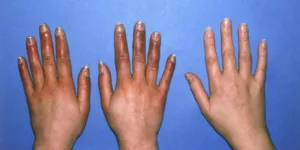Peripheral Artery Disease (PAD) currently affects 18 million Americans. There are countless other cases around the world. This is not solely an American problem – it is a global issue.
PAD is a chronic disease that arises when the arteries that supply oxygen-enriched blood to the body become blocked. PAD can be caused by the accumulation of cholesterol, calcium, and plaques on the internal walls of the arteries. This is especially true for the arteries that supply the extremities.
With peripheral arterial disease, the arteries become too narrow. This reduces the flow of blood to different parts of the body. For instance, when the arteries in the leg narrow, the leg muscles are not sufficiently supplied with blood. This becomes an even bigger problem during physical activity. When the muscles are in a state of rest, the supply of blood can often return to normal.
Symptoms
The main symptom of peripheral arterial disease in the legs is severe, compressive pain in the calf, foot or buttocks during exercise. A sufferer might notice this more acutely when climbing up a ladder or a hill, running or walking. This pain is called ‘intermittent claudication’ and usually passes during rest. If the condition worsens, leg pain might start to appear during minimal activity or even during rest.
Apart from the pain, other signs of peripheral arterial disease of the legs are as follows:
– Weakness in the extremities and loss of balance when in the standing position.
– A sensation of cold and numbness in the feet or toes.
– Wounds that are slow to heal.
If over time there is a severe disturbance of the blood supply, ischemia of the lower extremities is formed. This is a condition in which there is a strong pain from the thigh to the fingertips, even at rest. If ischemia becomes an issue on the lower limbs, ulcers can occur. If the ulcers are not treated, soft tissue necrosis and gangrene can occur.
Risk factors
Factors that increase the likelihood of peripheral vascular disease include:
ϖ Diabetes
ϖ Cigarette smoking
ϖ High blood pressure
ϖ Cardiac ischemia
ϖ Stroke
ϖ High cholesterol
ϖ Age: over 50 years
ϖ High levels of homocysteine in the blood
ϖ Male gender
ϖ A family history of the peripheral vascular disease.
Diagnosis
Traditional diagnosis of PAD begins with a thorough questioning of the patient. A specialist will want to assess the patient’s blood pressure, the presence of bad habits, and other aspects of his or her health. The patient should inform the doctor about all of the symptoms. The doctor will then examine the patient’s legs. It relies heavily on the patients already experiencing symptoms.
To diagnose PAD, the doctor conducts specialized tests that can determine the presence or absence of lesions. These tests include measuring the arterial pressure of the hands and feet to determine the ankle brachial pressure index. A doctor will also measure blood cholesterol levels to examine the state of the cardiovascular system. These tests can be very expensive and be deterring.
PAD diagnosis usually involves the use of instrumental studies. These include ultrasound duplex scanning of the arteries of the extremities, allowing the doctor to assess the blood flow and structure of the extremities. A doctor might also use Doppler effect sensors, and cuffs that determine the amount of blood flowing through the different leg veins. Doctors may recommend one of these other tests such as angiography with X-rays or a MRA (Magnetic Resonance Angiography).
The QuantaFlo™ System from Semler Scientific is becoming more popular test amongst practices and clinics. This specialized system helps to check for PAD within 5 minutes. This is the least time-consuming test available today to diagnose PAD. QuantaFlo™ system also allows the doctor to diagnose peripheral artery disease before crippling symptoms appear.
Treatment of peripheral arterial disease
PAD treatment is complex in nature. The initial step is lifestyle modification. An optimal level of physical activity is required for the best results. Physical exercise is the initial treatment for intermittent claudication. It is often recommended that patients walk for 1-2 hours, 3-4 times a week for 5-6 months.
It is necessary to walk until there one feels the intermittent claudication; this usually takes between 2-4 minutes. After that, the walking should be continued until the patient can still endure the pain. This often takes about 8-10 minutes. After this, the exercise needs to be stopped until the pain is completely gone, and then the walking should resume.
In addition to walking, patients should perform other exercises that help maintain muscle tone. This complex range of exercises is aimed at maintaining a certain level of muscle strength and increase the blood flow through the arteries.
Apart from lifestyle modification, medications can be utilized. Hypolipidemic drugs or cholesterol decreasing drugs, and medication for high blood pressure can all be prescribed. Antiplatelet drugs (such as low dose aspirin) can also be used as a prophylaxis to prevent the development of blood clots.
If a conservative treatment approach does not help, the disease is treated surgically. Angioplasty and stenting (in which the normal size of the vessels is restored) can be performed. The shunting of arteries involves the creation of a bypass using another blood vessel. An endarterectomy is then performed, in which the removal of atherosclerotic plaque is achieved. In exceptional cases, amputation can be necessary if gangrene has developed. In the light on the disastrous consequences of PAD, early detection is critical. With the QuantaFlo™ System, health-conscious patients have an FDA-approved digital device focused on diagnosing risks of developing PAD as early as possible, in a cost-effective
manner.








